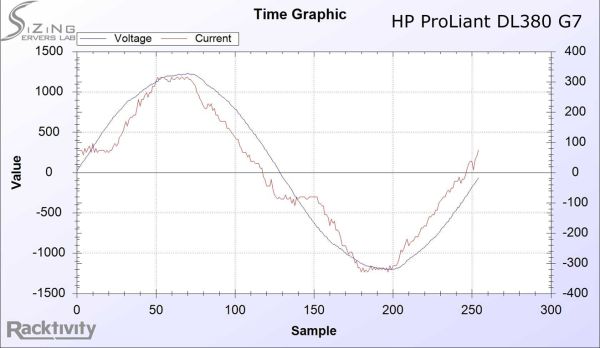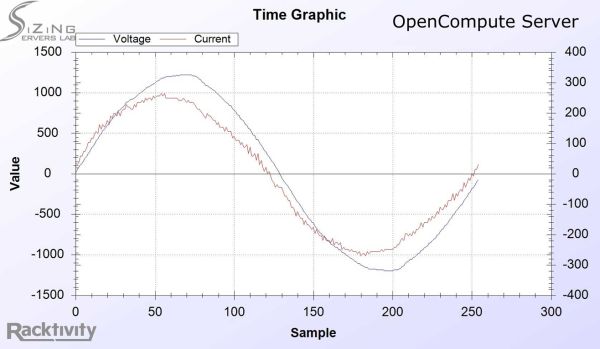Facebook's "Open Compute" Server tested
by Johan De Gelas on November 3, 2011 12:00 AM ESTPower Supply Efficiency Visualized
I graduated as an electromechanical engineer, but 17 years of IT jobs and research have helped me forget a lot about electricity and electronics. However, I have the advantage of running the Sizing Servers Lab (at the university college of West-flanders, Howest) and thus the privilege of working with some very talented people. Tijl Deneut told me he would be able to visualize the efficiency of the power supply. So with the advanced Racktivity PDU, he managed to produce a time graphic that shows how close the current sine wave remains to to the voltage sine wave. If the two are perfectly in phase, the power quality or power factor is 100%.
In your own home, this power factor is less important. However, large installations such as a data centers have to pay extra for bad power factors as a low power factor causes the electrical system to draw more current for the same amount of work being done, and more current results in higher heat losses.
Data centers have large power factor correctors, electronic systems with large capacitors that improve the PF but also consume energy. A bad PF can increase the Power Usage Effectiveness (PUE) of the data center, and this PUE has become an extremely important "benchmark" for data centers. The less these systems have to work the better, so the PF of a server PSU should be as close to 1 as possible.
We started by measuring while the server is close to idle, which is a pretty bad scenario for the PF. First let's look at the sine waves of the HP DL380 G7:
That's not bad at all, but next let's look at the sine waves of the AC that enters the Open Compute server
The current sine wave is not only closer to the voltage sine wave, it is also much closer to the ideal form of an AC sine wave, which makes energy delivery more efficient. It is one of the first indications that the Facebook engineers did their homework very well.












67 Comments
View All Comments
harrkev - Thursday, November 3, 2011 - link
You should look again at the sine-wave plots. Power factor has more to do with the phase of the current and not so much how much like a sine-wave it looks like.As an example, a purely capacitive or purely inductive load will have a perfect sine wave current (but completely out of phase with the voltage), but have a power factor very close to zero...
So, those graphs do not really tell us much unless you actually crank the numbers to calculate the real power factor.
http://en.wikipedia.org/wiki/Power_factor#Non-line...
ezekiel68 - Thursday, November 3, 2011 - link
On page 2:"The next piece in the Facebook puzzle is that the Open Source tools are Memcached."
In fact, the tools are not memchached. Instead, software objects from the PHP/c++ stack, programmed by the engineers, are stored in Memcached. Side note - those in the know pronounce it "mem-cache-dee", emphasizing with the last syllable that it is a network daemon. (similar to how the DNS server "bind" is pronounced "bin-dee") So the next piece is Memcached, but the tools are not 'memcached'.
JohanAnandtech - Thursday, November 3, 2011 - link
That is something that went wrong in the final editing by Jarred. Sorry about that and I feel bad about dragging Jarred into this, but unfortunately that is what happened. As you can see further, "Facebook mostly uses memcached to alleviate database load", I was not under the impression that the "Open Source tools are Memcached. " :-)ezekiel68 - Thursday, November 3, 2011 - link
I was pretty sure it was a mistake and I only mentioned it to have the blemish removed - I've been following and admiring your technical writing since the the early 2000s. Please keep on bringing us great server architecture pieces. Don't worry about Jarred, he's fine too. We all make mistakes.Dug - Thursday, November 3, 2011 - link
I'm curious what the cost would be on the servers compared to something like the HP.Lucian Armasu - Thursday, November 3, 2011 - link
According to SemiAccurate, Facebook is considering Calxeda's recently announced ARM servers, too. It could be a lot more efficient to run something like Facebook on those types of servers.JohanAnandtech - Thursday, November 3, 2011 - link
I personally doubt that very much. The memcached servers are hardly CPU intensive, but a 32 bit ARM processor will not fit the bill. Even when ARM will get 64 bit, it is safe to say that x86 will offer much more DIMM slots. It remains to be seen how the ratio Watt/ RAM cache will be. Until 64 bit ARMs arrive with quite a few memory channels: no go IMHO.And the processing intensive parts of the facebook architecture are going to be very slow on the ARMs.
The funny thing about the ARM presentations is that they assume that virtualization does not exist in the x86 world. A 24 thread x86 CPU with 128 GB can maybe run 30-60 VMs on it, lowering the cost to something like 5-10W per VM. A 5W ARM server is probably not even capable of running one of those machines at a decent speed. You'll be faced with serious management overhead to deal with 30x more servers (or worse!), high response times (single thread performance take a huge dive!) just to save a bit on the power bill.
As a general rule: if the Atom based servers have not made it to the shortlist yet, they sure are not going to replace it by ARM based ones.
tspacie - Thursday, November 3, 2011 - link
The FaceBook servers take a higher line voltage for increased efficiency. What voltage was supplied to the HP server for these tests?JohanAnandtech - Thursday, November 3, 2011 - link
Both servers used 230V. I have added this to benchmark page (Thanks, good question). So in reality the Facebook server can consume slightly less.Alex_Haddock - Thursday, November 3, 2011 - link
TBH we'd position SL class servers for this kind of scenario rather than DL380G7 (which does have a DC power option btw) so not sure it is a relevant comparison. Though I understand using what is available to test.